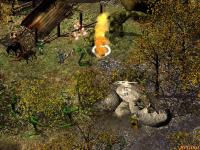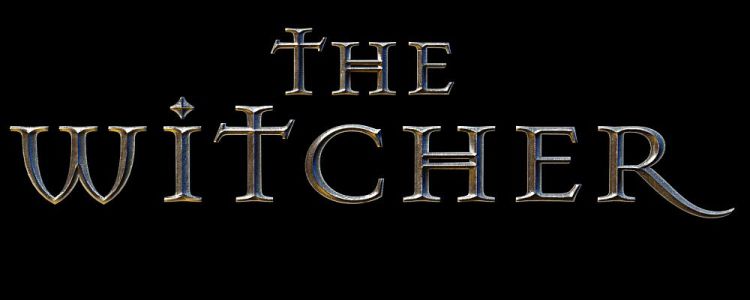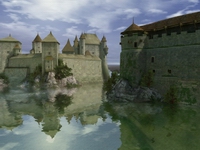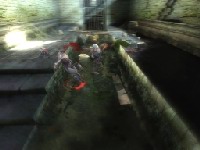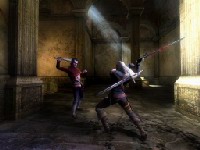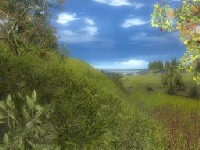|
|
|
Main News Forums Games Games Database Top 100 Release List Support Files Features Reviews Previews Interviews Editorials Diaries Misc Download Gallery Music Screenshots Videos Miscellaneous Staff Members Privacy Statement |
A Look at The Witcher
Unless you have been following The Witcher, there's every chance the name Andrzej Sapkowski will mean little. The world created by Poland's best-selling fantasy author is the basis of CD Projekt's ambitious action RPG, which combines a dark Eastern European medieval world full of moral ambiguity with motion-captured swordfighting and some bold design ideas that should set The Witcher apart. Players will take on the role of Geralt, trained as a warrior sword-specialist from birth, subjected to mutations and trials to produce a super-human fighter - a Witcher - travelling the world to kill monsters for coin. No mere mercenaries, Witchers only bother with magical creatures - undead, werewolves and the like. While the Witcher brotherhood has a long tradition, their social position is complex and they are shunned by polite society. In gameplay terms, The Witcher is an action-RPG with players controlling a single character from a 3rd-person perspective. The Witcher is built on BioWare's Aurora engine - the code that powered Neverwinter Nights - although you certainly wouldn't know it to look at it. As the Polish publisher of Neverwinter Nights, CD Projekt has experience localising the title for the Polish market and obviously sought to leverage that knowledge when they decided to develop their own RPG. With a completely re-written, up-to-date renderer and no tiles, The Witcher looks spectacular. Beyond the technology, there's a distinctive look that comes from a combination of the Eastern European setting that yields a darker edge than typical fantasy fare, along with an element of gritty realism. There's a sense that this is a real, dirty, harsh world with people struggling to survive. This level of realism extends beyond the art to the gameworld itself. People will behave realistically, going about their daily business and coming and going according to the time of the day - in fact, time is an important factor in The Witcher. In the demo we saw, washer-women cleaning clothes down by the river in the morning made way for bandits and thieves roaming the city streets at nights. While this passing of time establishes an authenticity and level of immersion in the world, it also has a direct impact on the player. The most exciting feature we saw was the number of potential paths CD Projekt is aiming to offer - including the effects of time just mentioned. In one example, CD Projekt walked us through a segment where the player had to find a key NPC, while assassins launched an unexpected attack on the building. Taking one way through the building, we came across a character that provided some assistance before we continued the search. Replaying the same segment but taking a different path led the player more directly to the key NPC, just in time to assist as the enemy arrived. However, by the time we made our way to where the other character was located, the assassins had already attacked. CD Projekt explained that both paths had different consequences further into the game, although they had taken care to make sure neither was the "right" or "wrong" way to go. In another example, we watched as Geralt returned with a valuable item to the streets of Vyzime after dark, only to be accosted by bandits - had Geralt returned during daylight, the streets would have been safer. In yet another encounter, an apparently evil creature presented Geralt with a moral dilemna; one choice provided a direct way forward while the other forced the player to seek out an alternative solution. The Witcher allows players to develop the morality of their character as they like but there may be consequences to those decisions. What's more, every NPC can be attacked. CD Projekt outlined how they designed different scenarios and ways to deliver information to players if they kill a story-critical NPC. All in all, The Witcher looks to offer players a degree of freedom and different experiences well beyond most action-RPGs.
Naturally, combat plays a key role in any action-RPG. CD Projekt is aiming to make combat in The Witcher an active experience for players through timed combos. Combat is point-and-click but rather than a Diablo-like, furiously-fast click-fest, players can chain attacks together with the right timing, clicking when the enemy selector turns green to signal the "optimal" time for the next stroke. Stringing together these attacks successfully unleashes combos that can be learned as part of the character development system. There's also a small element of strategy, with three different attack styles that can be selected: fast, strong and group attack. The first style is designed for weaker or fast-moving enemies but delivers weaker blows, while the next provides slower but stronger blows for larger, slow-moving enemies. Finally the group style is designed to deliver blows to multiple enemies at once. On a different note, fighting without weapons is non-lethal: a fistfight in a tavern might be just the thing to intimidate someone into giving up some much-needed information. All of this is wrapped up with spectacular animations based on motion-captured sequences from real sword-masters, visible damage as combatants get hurt and ragdoll physics from the licensed Karma engine. Another important aspect of the The Witcher is the Alchemy system. Components can be gathered from fallen monsters and combined in different ways to produce elixirs. CD Projekt hinted at a large number of recipes and far-ranging optional sidequests to obtain more obscure recipes and components. In an interesting twist, every elixir has a poisonous side effect, with each consumed adding to the level of poison in Geralt's system - and ultimately fatal. Meditation in a tavern or safe area cleanses the effects but players will have to weigh the benefits of elixirs against the increasing danger. One area we'd like to see more detail on is the character development and equipment system. If there's a question mark over the design, it's whether the restrictions of Sapkowski's Witchers - sword-wielding, low-magic warriors - provide enough scope for players to develop their own unique characters. We fired off a few questions to CD Projekt to shed some more light on these areas and we'll bring you those answers in a day ot two. The game length is estimated at around 30 hours for the main story arc - with another 50 hours if players pursue every side quest. With development around 20 months in, CD Projekt hopes to be code-complete by the end of this year, with some months of balancing and polishing to follow. If CD Projekt can successfully pull these elements together and find a way to provide satisfying character development within the specific fiction of the gameworld, The Witcher looks to be a unique action game with an unprecedented number of paths for a game of this type, along with an intriguing and harshly beautiful game world to explore. CD Projekt |
|||||||
|
All original content of this site is copyrighted by RPGWatch. Copying or reproducing of any part of this site is strictly prohibited. Taking anything from this site without authorisation will be considered stealing and we'll be forced to visit you and jump on your legs until you give it back. |
||




